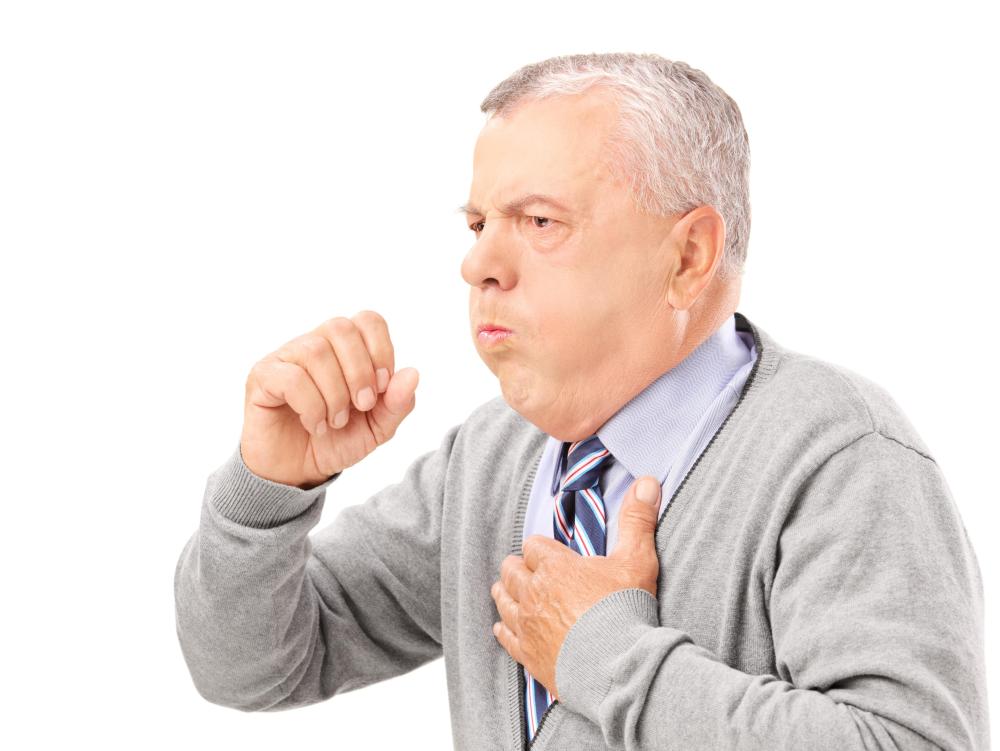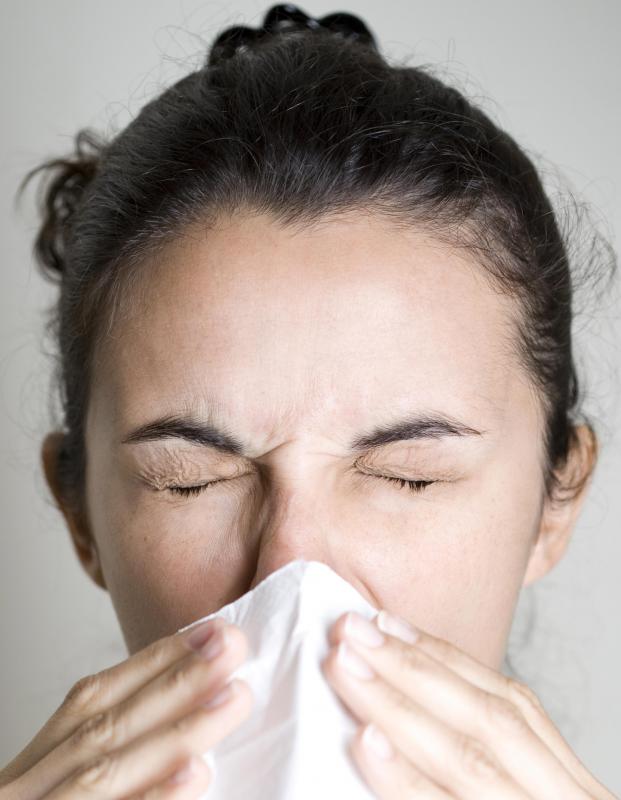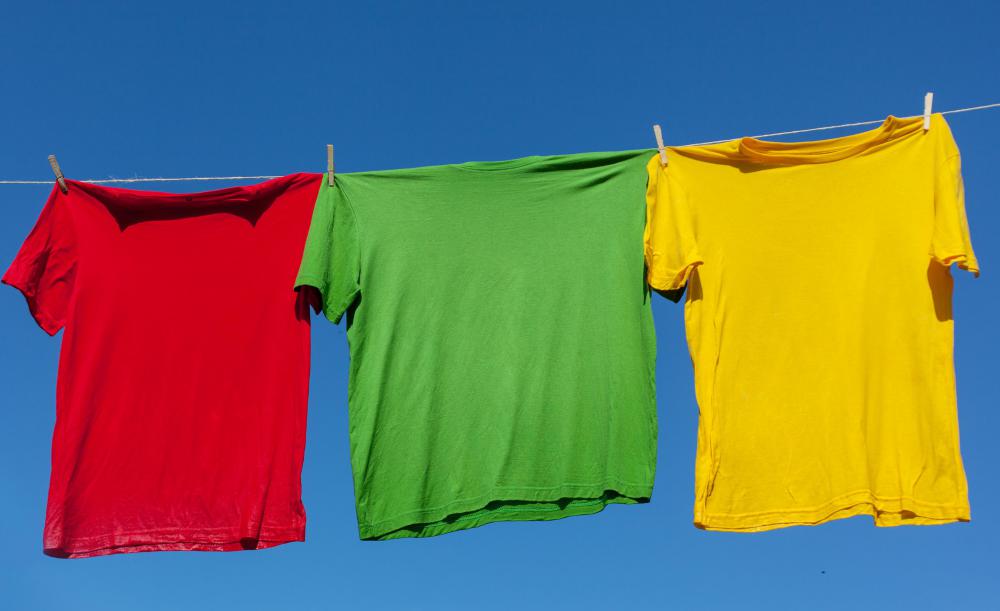At AllThingsNature, we're committed to delivering accurate, trustworthy information. Our expert-authored content is rigorously fact-checked and sourced from credible authorities. Discover how we uphold the highest standards in providing you with reliable knowledge.
What is Mold?
A mold is a type of fungus: a plant-like organism that does not use photosynthesis to produce food, but instead obtains it directly from its surroundings. Molds can display themselves in a variety of colors, such as the familiar green covering often seen on bread or fruit, but this is due only to the reproductive part of the organism — the fungal equivalent of flowers and fruit. The main part of the fungus consists of a network of thin, transparent filaments known as hyphae, which is much less visible.
These fungi can grow on a variety of materials, including soil, decaying plant parts, food, fabrics, and damp walls. They reproduce by releasing huge numbers of tiny spores, which are very tough, and can withstand drying and freezing. Although mold can be a nuisance, and occasionally a health hazard, they can also be useful; they are essential for the breakdown of dead organic matter in the natural environment, they are a valuable source of antibiotics and drugs, and are employed in the production of some foods.
In the Home

Humans have lived with molds for millennia, but in a modern domestic setting, they can cause problems. The black type that forms on damp surfaces such as bathroom walls is unsightly, and may cause damage to the structure. When large quantities of spores become airborne, they can cause a variety of unpleasant symptoms. Some people are allergic to these fungi, and may experience coughing and sneezing, eye irritation, and skin rash. People with asthma, however, may experience more severe problems, such as breathing difficulties.

The spores are constantly present in the atmosphere, and little can be done about them; however, they do not pose any direct threat at the low concentrations normally found in outdoor air. It is when they are produced in large amounts in an enclosed, indoor space that they may have health effects. While spores can survive harsh conditions, the molds themselves require moisture and some degree of warmth to grow. Damp areas in the home are ideal for them, especially if they have poor air circulation and receive limited amounts of natural light, so they are common in bathrooms, basements and attics. When spores land on a damp, indoor surface, they can germinate and form mold that spreads rapidly.
Dealing with Molds

If a homeowner is tackling a mold problem himself, it is in his best interest to invest in some kind of face mask to avoid inhaling particles and spores. A surgical mask, or the type used by carpenters to keep from inhaling saw dust, works well for this task. A long sleeved shirt and long pants should complete the protective outfit.
Mold can be removed by scrubbing the area with warm water and detergent, then allowing it to dry. An additional step of disinfecting the area with a solution of 1 gallon of water (about 3.8 liters) to 1/4 cup (about 60 milliliters) of bleach and then letting it air dry is recommended. This step can be repeated to ensure that most, if not all, of the mold is eliminated. There are also commercial removal products available that are normally sprayed onto the affected area.

To permanently get rid of the problem, however, the source of dampness must be eliminated. The most common reason for dampness is high humidity in places such as bathrooms or sometimes kitchens, and as a result of hanging damp clothes up to dry indoors. Solutions include improving ventilation, dehumidifiers, air conditioning, and drying clothes outdoors, if practical, or using a tumble drier. Other sources of dampness may be leaking roofs, leaking pipes or seepage from wet ground, which may require professional help to fix.
Uses

The toxins produced by some species of mold are very effective at killing bacteria, and this discovery led to the development of antibiotics. The first such compound to be discovered was penicillin, in 1928. It revolutionized the treatment of many infectious diseases and since then, a number of other compounds of medical interest have been obtained from these fungi.
Some types are also used in the manufacture of food. They are essential to many types of cheese, such as Camembert and Stilton. The production of soy sauce depends, at an early stage, on the growth of a type of mold on the raw material.
Frequently Asked Questions
What exactly is mold?

Mold is a type of fungus that consists of small organisms found almost everywhere. It can be black, white, orange, green, or purple and lives on moisture, reproducing by means of tiny, lightweight spores that travel through the air. Molds play a crucial role in nature by breaking down dead organic matter, but they can also be problematic indoors, leading to property damage and health issues.
How does mold grow and spread?
Mold grows by digesting organic material, spreading and reproducing through spores, which are airborne and can settle on surfaces. For growth, mold requires moisture, so it often appears in damp or water-damaged areas. According to the Environmental Protection Agency (EPA), controlling indoor humidity and promptly fixing leaks can significantly reduce the spread of mold indoors.
Is mold dangerous to human health?
While mold is not harmful to everyone, it can cause health issues, especially for those with allergies, asthma, or compromised immune systems. Exposure to mold can lead to symptoms such as sneezing, runny nose, red eyes, and skin rash. The Institute of Medicine (IOM) found evidence linking indoor mold exposure with respiratory tract symptoms in otherwise healthy individuals.
Where is mold most commonly found in homes?
Mold commonly thrives in damp, warm, and humid environments, often found in basements, bathrooms, kitchens, and areas with poor ventilation. It can grow on a variety of materials, including wood, paper, carpet, and foods. The Centers for Disease Control and Prevention (CDC) advises keeping indoor humidity levels below 50% to help control mold growth.
Can mold be completely eliminated from a home?
It is impossible to remove all mold and mold spores indoors since they are naturally present in the air and on surfaces. However, mold growth can be controlled by addressing water damage and maintaining low humidity levels. Professional remediation can effectively remove extensive mold infestations, ensuring a healthier living environment.
How can I prevent mold growth in my home?
Preventing mold growth involves controlling indoor moisture levels. Use dehumidifiers and air conditioners to maintain low humidity, ensure proper ventilation in high-moisture areas, fix leaks promptly, and dry water-damaged areas within 24-48 hours to prevent mold from taking hold. Regular household cleaning and maintenance also play a key role in preventing mold growth.
AS FEATURED ON:
AS FEATURED ON:
















Discussion Comments
This is very informative post!
Does mold form on human bones?
When do you know if you should be calling a mold specialist? I have been researching the topic of DIY mold removal, and found an article online about how people can say they are licensed by simply paying 50 dollars for a certificate and buying a book!
Testimonials are also a sure fire way to know if a mold professional is qualified or not. People typically don't gain anything from leaving a review, so you can generally trust a review left by a customer. When I am researching hiring a company, that is where I will usually put most of my stock.
@KaBoom - Household mold can be really dangerous. Especially if you have mold allergies! From what I've read, when a home develops a mold problem, usually people with allergies will start feeling bad first.
However, anyone can be affected by mold, especially depending on what kind of mold it is. Some kinds are more toxic than others!
Keeping your house free of mold is really important, because it can make you really, really sick. A good friend of mine had mold in her house, and her whole family was suffering from mold symptoms for months before they figured out what the problem was!
@strawcake - That's good to know about porous surfaces, and it makes sense. With something like a couch, the mold probably gets inside of it. Whereas if you get mold on a tile wall, the mold is only present on the outside.
One other thing I do to prevent household mold is that I make sure my bathroom is well ventilated. I run the fan after I take a shower every time, so that moisture doesn't sit around the bathroom any longer than it has to!
@anon52008 - The article pretty much covered how to get rid of mold. You clean it up, and then get rid of the source for the moisture. If there is too much mold, you can call in a professional!
One other thing I wanted to add though, is that if you get mold on something porous, you have to throw it away. This includes things like couches and curtains.
Which type of food that allows mold to grow faster?
Why does mold grow on milk?
What is a mold spore? I need to know for my science fair project due tomorrow. Help me please.
what use can mold be for?
Is it dangerous? i am doing a project on whose mouth is cleaner a dog's or human's but i am worried because bacteria grows and petri dishes and is it dangerous for me? i am in the sixth grade and eleven and i can't even change my project.
is mold bad to eat? can you die right after eating mold.is mold dangerous. i am doing a project on mold. --lannie
I am dong my science project on this. I have also a question: are bacteria and mold related? I do believe they are. Bacterial cells are single celled and prokaryotic. Thanks for the help. I need to start on my homework as soon as possible (writing and listening to the man who can't be moved at the same time). -Patricia
How does mold grow on plants if they are still alive? maybe you should include if the plant is alive or dead.
Is there a way to see mold spores flying in the air?
This article was helpful but I think there should be more facts. Like whether it is headotropic or not and if it's Eukaryotic or not.
Nice article, All this information is very helpful for me and my science project. i hope i complete my project successfully with this info.
very informative article. last night i was really worried how to make my assignment on this topic. i have downloaded so much on this topic, but this article helped me a lot. thanks.
Thanks this is very helpful!
this is very helpful. Thank you
this is very helpful.
thanks guys you helped me a lot with my science project. i have to write a 500 word essay on bread and mold so thanks again.
gee thanks. this helped me.
For comment 1: worse. Geez. Who doesn't know that!
Why would anyone study mold long enough to gather enough information to create an entire page about it?
This was very helpful for my science fair project.
Mold is the best! i learned a lot from you nerds. it was the best! Thanks guys!
Thank you. this really helped me with my science fair project.
I am doing a project on bread mold and i was wondering how many different types of bread mold there are.
thanks that really helped on my science fair project!
Thanks! i'm in seventh grade and this helped a lot in my "Mold Mania" science fair project. i understand a lot better now.
i am in the fourth grade and I'm doing a science project. if you can post please answer: What is the best condition for the growth of mold? Thank you so much!
i understand now.
It's really a reliable source for my questions.
thanks.
Does mold grow faster inside or outside of the home?
i am doing a science fair project on mold!
do you have anything else besides these suggestions on how to get rid of mold?
Thanks wise guy so much for this information. i guess you already heard this, but i'm in the sixth grade and i am doing a science project and your information really helped.
the warmth makes it worse because that is how it is made.
Can't you guys spell mold?
This is awesome. im in seventh grade and you just did my science project.
This was great! But I'm in year 9, and you just helped me with a difficult second paragraph in my intro for a stupid assignment! Thank you.
thanks guys; you did my homework. Awesome!
there is so much info. you guys just did my homework!
there is so much info on this article i am in 6th grade its awesome!!!
I am working on a project for school and I am in 6th grade. I was wondering if this site had a mold glossary on different types of molds such as: toxigenic, pathogenic, etc. I was unable to find this information however, the What Is Mold article was very helpful. If you can please post any answers you may have on the what is Mold article on Friday or Saturday, February, 27 or 28! If you do not, thankyou anyway.!!!
get back to me ASAP,
Anonymous (:
Does a warmer area surrounding food prevent mold better or worse?
Post your comments